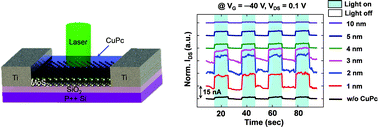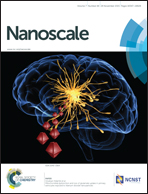Enhancement of photodetection characteristics of MoS2 field effect transistors using surface treatment with copper phthalocyanine†
Abstract
Recently, two-dimensional materials such as molybdenum disulfide (MoS2) have been extensively studied as channel materials for field effect transistors (FETs) because MoS2 has outstanding electrical properties such as a low subthreshold swing value, a high on/off ratio, and good carrier mobility. In this study, we characterized the electrical and photo-responsive properties of MoS2 FET when stacking a p-type organic copper phthalocyanine (CuPc) layer on the MoS2 surface. We observed that the threshold voltage of MoS2 FET could be controlled by stacking the CuPc layers due to a charge transfer phenomenon at the interface. Particularly, we demonstrated that CuPc/MoS2 hybrid devices exhibited high performance as a photodetector compared with the pristine MoS2 FETs, caused by more electron–hole pairs separation at the p–n interface. Furthermore, we found the optimized CuPc thickness (∼2 nm) on the MoS2 surface for the best performance as a photodetector with a photoresponsivity of ∼1.98 A W−1, a detectivity of ∼6.11 × 1010 Jones, and an external quantum efficiency of ∼12.57%. Our study suggests that the MoS2 vertical hybrid structure with organic material can be promising as efficient photodetecting devices and optoelectronic circuits.


 Please wait while we load your content...
Please wait while we load your content...